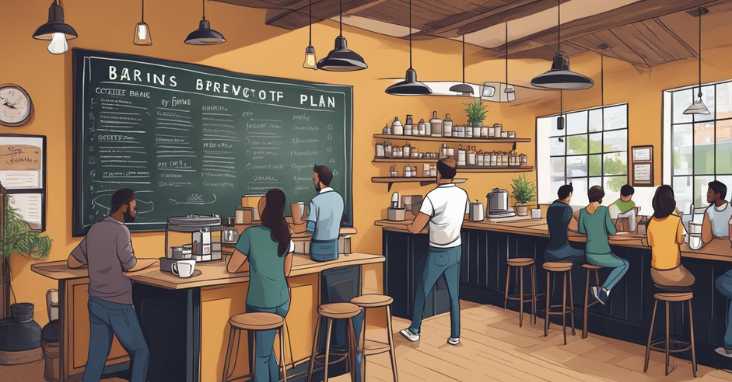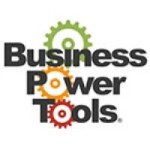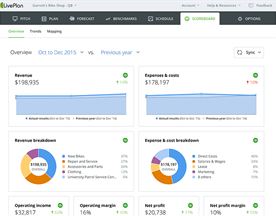What is the best coffee shop business plan ? The best coffee shop business plan details your vision, target market, menu, budget, location, marketing strategy, and operational plan for a successful café launch.
A coffee shop business plan is a crucial document that outlines the strategy, goals, and financial projections of a coffee shop. It serves as a roadmap for the business owner to follow and helps secure funding from investors or lenders. A well-crafted business plan can also help identify potential challenges and opportunities, allowing the owner to make informed decisions and adjust their approach accordingly.

When creating a coffee shop business plan, it’s important to consider various factors such as the target market, location, competition, and marketing strategy. The plan should also include an operational plan that outlines the day-to-day operations of the business, as well as a financial plan that projects revenue, expenses, and cash flow. Additionally, the plan should address the brand and customer experience, highlighting what makes the coffee shop unique and appealing to customers.
Overall, a coffee shop business plan is a vital tool for anyone looking to start or expand a coffee shop. By providing a clear roadmap and financial projections, it can help secure funding and guide the business towards success. For more information on creating a coffee shop business plan, check out this resource from the Small Business Administration.
Key Takeaways
- A coffee shop business plan outlines the strategy, goals, and financial projections of a coffee shop.
- It should consider factors such as the target market, location, competition, and marketing strategy.
- The coffee shop business plan should include an operational and financial plan, as well as address the brand and customer experience.
Executive Summary
Starting a coffee shop business plan requires a solid plan to ensure success. In this executive summary, the business concept, vision, mission, and objectives, as well as success metrics, will be discussed.
Business Concept
The coffee shop will be a cozy and comfortable place where customers can relax, socialize, and enjoy high-quality coffee and pastries. The shop will offer a variety of coffee blends, teas, and snacks to cater to different tastes. The coffee shop will also provide free Wi-Fi and comfortable seating to encourage customers to stay longer.
Vision, Mission, and Objectives
The vision of the coffee shop is to become the go-to place for coffee lovers in the local community. The mission is to provide exceptional customer service and a welcoming atmosphere that will make customers want to return. The objectives are to increase revenue by 20% in the first year, expand the menu to include more food options, and open a second location within five years.
Success Metrics
To measure the success of the coffee shop, the following metrics will be used:
- Revenue growth: The coffee shop aims to increase revenue by 20% in the first year and maintain steady growth in the following years.
- Customer satisfaction: The coffee shop will regularly conduct customer surveys to ensure that customers are satisfied with the quality of the coffee and pastries, as well as the overall atmosphere.
- Repeat business: The coffee shop aims to have a high percentage of repeat customers, which will be tracked through a loyalty program.
To learn more about creating a successful coffee shop business plan, check out this article by Inc. magazine.
Company Overview
A coffee shop business plan is an essential document that outlines the company’s goals, strategies, and tactics to achieve success in the highly competitive coffee industry. The company overview section provides a brief introduction to the coffee shop and its owners.
Management Team
The management team is responsible for the day-to-day operations of the coffee shop. The team should have the necessary skills and experience to manage a coffee shop successfully. The team should include the owner, manager, and other staff members.
The owner should have experience in the coffee industry and have a passion for coffee. The manager should have experience in managing a coffee shop and have excellent customer service skills. The staff members should be trained to provide excellent customer service and have a passion for coffee.
Location and Facilities
The location of the coffee shop is crucial to its success. The coffee shop should be located in a high-traffic area with easy access to public transportation. The facility should be spacious enough to accommodate customers comfortably and have a welcoming atmosphere.
The coffee shop should have high-quality equipment and supplies to ensure that the coffee is of the highest quality. The coffee shop should also have a variety of seating options, including tables, chairs, and sofas.
To learn more about coffee shop business plans, interested parties can visit Entrepreneur’s article on the topic.
Market Analysis
Industry Background
The coffee shop industry is a highly competitive and rapidly growing industry. According to Statista, the global coffee shop market size was valued at $201.56 billion in 2019 and is expected to reach $342.91 billion by 2027, growing at a CAGR of 7.3% from 2020 to 2027. The industry has been driven by the increasing number of coffee drinkers, changing consumer preferences, and the rising trend of socializing in coffee shops.
Target Market
The target market for coffee shops includes a wide range of customers, including students, professionals, and tourists. The coffee shop industry has seen a growing trend of younger consumers who are interested in specialty coffee and are willing to pay a premium price for it. According to National Coffee Association USA, 72% of millennials drink coffee daily, making them the largest coffee-consuming generation.
Competition
The coffee shop industry is highly competitive, and there are many established players in the market. The competition ranges from large chain coffee shops to independent coffee shops. According to IBISWorld, the top players in the industry include Starbucks, Dunkin’, and Tim Hortons. Independent coffee shops also play a significant role in the market, accounting for 51.7% of industry establishments.
Market Trends
The coffee shop industry is constantly evolving, and there are several trends that have emerged in recent years. One of the most significant trends is the increasing demand for specialty coffee, which is made from high-quality beans and prepared using various brewing methods. Another trend is the rising popularity of plant-based milk alternatives, such as almond milk and oat milk, as more consumers are becoming health-conscious. Additionally, there has been a growing trend of coffee shops offering food items, such as breakfast sandwiches and pastries, to attract more customers.
In conclusion, the coffee shop industry is a highly competitive and rapidly growing industry that has been driven by changing consumer preferences and the rising trend of socializing in coffee shops. To succeed in this industry, coffee shop owners must stay up-to-date with the latest market trends and offer high-quality coffee and food items that cater to their target market.
Marketing Plan

Products and Services
The coffee shop offers a variety of high-quality coffee blends, teas, pastries, and sandwiches. The shop uses only premium ingredients and locally sourced products to ensure the best possible taste and quality. The menu is updated regularly to keep up with the latest trends and customer preferences.
Pricing and Sales
The pricing strategy is designed to be competitive with other coffee shops in the area. The shop offers discounts for repeat customers and loyalty programs to encourage customer retention. Additionally, the shop offers special promotions and seasonal items to attract new customers and increase sales.
Marketing and Advertising
The coffee shop uses a combination of online and offline marketing strategies to reach its target audience. The shop advertises in local newspapers, magazines, and on billboards to increase brand awareness. The shop also uses social media platforms such as Facebook, Instagram, and Twitter to engage with customers and promote its products and services.
Social Media Strategy
The coffee shop’s social media strategy is focused on creating engaging content that resonates with its target audience. The shop uses high-quality images and videos to showcase its products and services. Additionally, the shop runs social media campaigns to increase engagement and attract new customers. The shop also partners with influencers and bloggers to increase its reach and credibility.
To learn more about creating a successful marketing plan and a coffee shop business plan, check out this article by Entrepreneur.
Operational Plan

The operational plan outlines the day-to-day activities of the coffee shop and the resources necessary to run it. This includes staffing and employees, equipment and inventory, and suppliers and partners.
Staffing and Employees
The success of a coffee shop business plan depends heavily on the quality of its staff. Hiring and training the right employees is crucial to ensure efficient operations and customer satisfaction. The coffee shop should have a clear job description for each position, including baristas, shift supervisors, and managers. The job description should outline the responsibilities, qualifications, and expected performance of each employee.
The coffee shop should also have a comprehensive training program for new employees. Training should cover the coffee shop’s policies and procedures, customer service, and equipment operation. Ongoing training should be provided to all employees to ensure they stay up-to-date with the latest techniques and equipment.
Equipment and Inventory
The coffee shop will need a range of equipment to operate, including espresso machines, grinders, blenders, refrigerators, and dishwashers. The coffee shop should have a detailed inventory of all equipment, including the manufacturer, model number, and purchase date. Regular maintenance and repairs should be scheduled to ensure all equipment is in good working condition.
The coffee shop will also need to maintain an inventory of supplies, including coffee beans, milk, syrups, and cups. The inventory should be regularly monitored to ensure that the coffee shop has sufficient supplies to meet customer demand.
Suppliers and Partners
The coffee shop will need to establish relationships with suppliers and partners to ensure a steady supply of high-quality products. The coffee shop should research and select suppliers based on their reputation, quality, and price. The coffee shop should have clear agreements with suppliers regarding pricing, delivery schedules, and quality standards.
The coffee shop should also consider partnering with local businesses and organizations to enhance its brand and reach new customers. For example, the coffee shop could partner with a local bakery to offer fresh pastries or with a nearby gym to provide healthy snacks and drinks.
Overall, the operational plan is critical to the success of the coffee shop. It ensures that the coffee shop has the necessary resources and processes in place to deliver high-quality products and services to its customers. For more information on creating an operational plan for a coffee shop, visit Small Business Administration.
Financial Plan

Revenue and Cost Projections
In order to create a successful coffee shop business plan, it is important to accurately project revenue and costs. The revenue projections should take into account the number of customers that are expected to visit the coffee shop, the average amount spent per customer, and any additional revenue streams such as catering or merchandise sales. On the other hand, cost projections should include expenses such as rent, utilities, supplies, equipment, and employee salaries.
Funding and Investment
Starting a coffee shop business plan requires a significant amount of funding. Entrepreneurs can secure funding from various sources such as personal savings, bank loans, and investors. It is important to determine the amount of funding required to start the business and create a plan to secure the necessary funds. Entrepreneurs should also consider the potential return on investment for their investors and present a clear plan for how the funds will be used to grow the business.
Profitability and Financials
The financials of a coffee shop business plan should include projections for revenue, expenses, and profits over a set period of time. This information can be used to determine the profitability of the business and to create a plan for growth and expansion. Entrepreneurs should also consider the potential risks and challenges that may impact the financial success of the business and create contingency plans to mitigate these risks.
To help create a realistic financial plan, entrepreneurs can use resources such as the Small Business Administration’s Financial Projection Template or consult with a financial advisor. By creating a comprehensive financial plan, entrepreneurs can increase their chances of securing funding and creating a successful coffee shop business plan.
Brand and Customer Experience

Unique Selling Proposition
A coffee shop’s unique selling proposition (USP) is what sets it apart from its competitors and attracts customers. The coffee shop’s brand identity plays a crucial role in determining its USP. A strong brand identity helps customers identify with the coffee shop’s values and mission, which in turn, helps the coffee shop stand out from the competition.
The coffee shop’s USP should be communicated clearly to the target audience. This can be achieved through marketing campaigns, social media, and in-store promotions. The coffee shop’s USP should be reflected in the coffee shop’s decor, menu, and customer service.
Customer Service and Satisfaction
Customer service is a critical aspect of the coffee shop business plan. The coffee shop’s customer service should be friendly, efficient, and personalized. Customers should feel valued and appreciated when they visit the coffee shop.
The coffee shop should strive to provide a positive customer experience. This can be achieved by offering high-quality products, a clean and comfortable environment, and excellent customer service. The coffee shop should also be responsive to customer feedback and complaints.
To ensure customer satisfaction, the coffee shop should conduct regular customer analysis to understand the target audience and their needs. This can be achieved through surveys, focus groups, and social media monitoring. The coffee shop should use this information to tailor its products and services to meet the needs of its target customers.
According to Entrepreneur, a coffee shop’s brand identity and customer experience are crucial to its success. By developing a strong brand identity and providing excellent customer service, the coffee shop can attract and retain loyal customers.
Additional Elements

Licenses and Permits
One of the most important aspects of opening a coffee shop is obtaining the necessary licenses and permits. This includes a business license, food service permit, and health department inspection. It is important to research and comply with all local, state, and federal regulations to avoid any legal issues.
Additionally, some coffee shops may require special permits to serve alcohol or host live music events. It is important to check with local authorities to determine what permits are necessary for your specific business.
For more information on licenses and permits for a coffee shop business plan, check out SBA’s Guide to Business Licenses and Permits.
Furniture and Design
The furniture and design of a coffee shop can greatly impact the overall atmosphere and customer experience. It is important to choose furniture that is comfortable and functional, while also fitting the overall theme and design of the shop.
Some coffee shops may opt for a minimalist, modern design while others may choose a cozy, rustic feel. It is important to consider the target audience and the desired atmosphere when making design decisions.
For more inspiration and ideas on coffee shop business plan and design, check out Coffee Shop Design Ideas.
Menu and Specialty Coffee
The menu and specialty coffee offerings are a crucial aspect of any coffee shop business plan. It is important to offer a variety of coffee options, including brewed coffee, espresso drinks, and specialty drinks.
In addition to coffee, many coffee shops offer baked goods and other food items. It is important to consider the target audience and local competition when deciding on menu offerings.
For inspiration and ideas on coffee shop menus, check out Coffee Shop Menu Ideas. And for information on sourcing high-quality coffee beans, check out Coffee Bean Direct for the best coffee shop business plan.
Appendices

Business Plan Template
A well-crafted business plan is the foundation of any successful coffee shop. It is important to have a clear understanding of the market, target customers, competition, and financial projections. A good business plan template should have the following sections:
- Executive Summary
- Company Description
- Market Analysis
- Products and Services
- Marketing and Sales Strategy
- Management and Organization
- Financial Projections
- Appendix
The appendix section should include supporting documents such as permits, licenses, legal documents, and resumes of key personnel. It is important to keep the appendix concise and easy to read.
Coffee Shop Business Plan Example
A coffee shop business plan example can be a great resource for entrepreneurs who are new to the industry. It provides a clear understanding of what a successful business plan should look like. A good example should include:
- Executive Summary
- Company Description
- Market Analysis
- Products and Services
- Marketing and Sales Strategy
- Management and Organization
- Financial Projections
- Appendix
It is important to note that every business plan is unique and should be tailored to the specific needs of the business. A coffee shop business plan example should be used as a guide, not a template.
For more information on how to write a coffee shop business plan, check out SBA’s Business Plan Template.
Frequently Asked Questions

What are the essential elements to include in a coffee shop business plan?
A coffee shop business plan should include a clear and concise executive summary, market analysis, competitive analysis, marketing and sales strategies, financial projections, and operational plan. The executive summary should provide a brief overview of the business plan and highlight the key points. The market analysis should identify the target market, competition, and industry trends. The competitive analysis should analyze the strengths and weaknesses of competitors. The marketing and sales strategies should outline the tactics to attract and retain customers. The financial projections should project revenue, expenses, and profits for the first three to five years. The operational plan should outline the day-to-day operations of the coffee shop.
How can I estimate the startup costs for opening a coffee shop?
The startup costs for opening a coffee shop can vary depending on the location, size, and equipment needed. An entrepreneur should consider the cost of rent, utilities, equipment, inventory, legal fees, and marketing expenses. It is important to create a detailed list of all the expenses and create a budget. An entrepreneur should also consider obtaining financing from investors or loans to cover the startup costs.
What are the key financial projections needed for a coffee shop business plan?
The key financial projections needed for a coffee shop business plan include revenue projections, expense projections, profit and loss projections, and cash flow projections. Revenue projections should estimate the amount of revenue the coffee shop will generate each month. Expense projections should estimate the monthly expenses such as rent, utilities, and inventory. Profit and loss projections should estimate the net profit or loss for each month. Cash flow projections should estimate the cash inflows and outflows for each month.
How do I define my target market in a coffee shop business plan?
Defining the target market is essential for a coffee shop business plan. An entrepreneur should consider the demographics, psychographics, and buying behavior of the target market. Demographics include age, gender, income, and education level. Psychographics include personality, values, and lifestyle. Buying behavior includes the frequency of visits, average spending, and preferences. By understanding the target market, an entrepreneur can tailor the marketing and sales strategies to attract and retain customers.
What marketing strategies should be outlined in a coffee shop business plan?
Marketing strategies for a coffee shop should include social media marketing, email marketing, local advertising, and events. Social media marketing can be used to engage with customers and promote the coffee shop. Email marketing can be used to promote specials and events. Local advertising can be used to attract new customers. Events can be used to create a sense of community and attract new customers.
What are the steps to create a competitive analysis for a coffee shop?
A competitive analysis for a coffee shop should include identifying the competitors, analyzing their strengths and weaknesses, and determining their market share. An entrepreneur should identify the direct and indirect competitors in the area. Direct competitors are other coffee shops, while indirect competitors are other businesses that sell coffee such as convenience stores. An entrepreneur should analyze the strengths and weaknesses of each competitor. This can include their location, prices, menu, and customer service. An entrepreneur should also determine the market share of each competitor to understand their position in the market.
One external resource with high authority about a coffee shop business plan is the Small Business Administration’s guide on writing a business plan.














